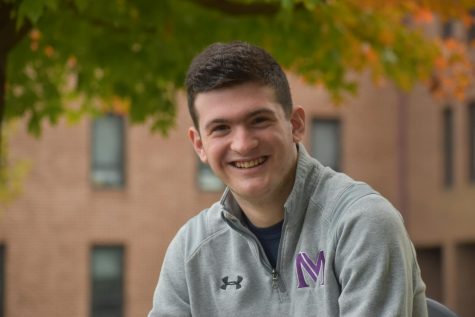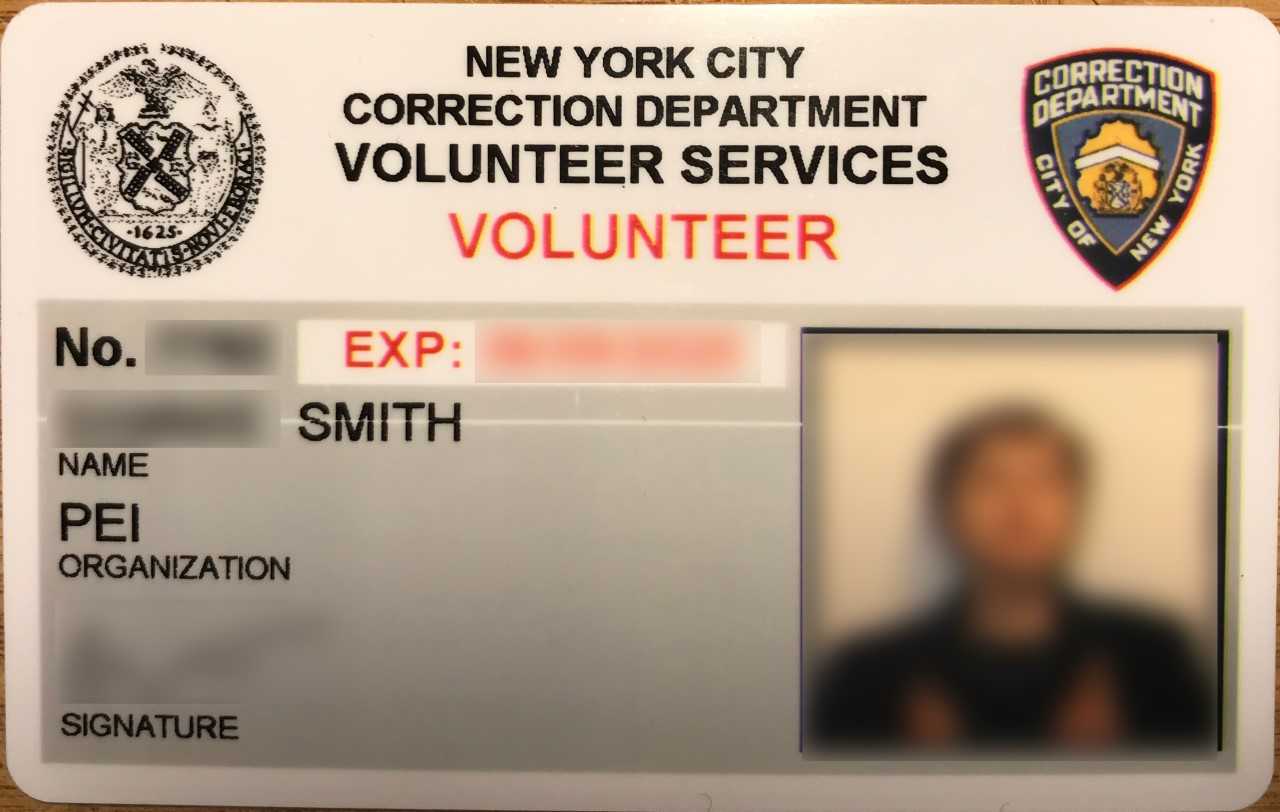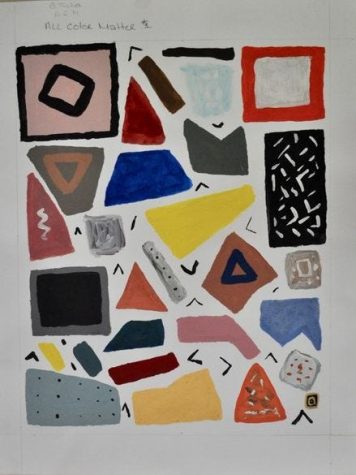
A senior from Hastings-on-Hudson, NY, Mitch Fink found his love for journalism in the sixth grade when he and fellow Tower staffer Logan Schiciano created...


February 5, 2021
Until the COVID-19 pandemic shut down New York State Correctional facilities in March 2020, Masters teachers Cheryl Hajjar and Smith spent many of their evenings inside the walls of local prisons, teaching incarcerated people through programs that facilitate learning in correctional facilities. Hajjar taught at Sing Sing Correctional Facility in Ossining, N.Y., while Smith volunteered at the Rose M. Singer Center, Rikers Correctional Facility’s women’s prison.
After her brother was incarcerated, Cheryl Hajjar swore she would never set foot in a prison again. So, her decision to teach at Sing Sing Correctional Facility was not an easy one.
When she was invited inside the walls of Sing Sing, a maximum-security prison in Ossining, N.Y., to attend a play years after her brother’s incarceration, she hesitated, but went.
The show was programmed through Rehabilitation Through the Arts (RTA), an organization which facilitates art programs in various prisons in the Hudson Valley. Hajjar was so touched by the performance that she reached out to Katherine Vockins, the founder and executive director of RTA, in hopes of teaching a visual arts course to those behind bars at Sing Sing.
Hajjar eventually sold Vockins on the idea, and joined RTA in 2007 as a volunteer visual arts teacher at Sing Sing, teaching every other Tuesday night from 6:15 p.m. until 8:30 p.m.
Hajjar’s classes were suspended due to the COVID-19 pandemic, but prior to the shutdown last spring, they were conducted in an atelier style of learning, where participants work alongside one another in a studio setting, giving feedback to each other and sharing in groups.
Hajjar would often bring class participants postcards, newspaper clippings and art exhibit reviews to connect them with the outside visual art realm. She sought to find examples from artists of color, or who may not have had the advantages of higher education––people who the students, many of whom were people of color with a High School education or less, could see themselves in.
In one project that Hajjar conceived, the participants designed style “mood boards.” Some of the boards included images of different designers and artists, or certain colors which spoke to them. Since many of the participants were fans of the renowned street artist Banksy, Hajjar designed another project where the participants created Banksy-inspired images, and then selected the location they would want to put their images if given the chance. Nearly all the participants chose the neighborhoods where they grew up, or their former high schools, so Hajjar and a few other teachers printed out large, full-color prints of the locations, and pinned them up on the classroom walls for the participants to place their images.
“It’s always a little bit about self, who I am and where I come from and my ideas, and a little bit about learning the craft of rendering,” Hajjar said.
George Tucker took Hajjar’s art course when he was incarcerated at Sing Sing. One of his abstract works, called “All Color Matter #1” was displayed outside the walls at an exhibition at the Ossining Public Library. The piece is abstract, but Tucker said that the work is meant to show that all colors––both in terms of racial and ethnic identity and in terms of the physical colors of the color wheel––matter.

Tucker was first incarcerated at the age of 15, went to prison at 18, and was released in March 2020 after 20 years behind bars, just as the pandemic was shutting down public life. Now, he is a member of the Ready, Willing & Able program in New York City, a 12-month program which provides many formerly incarcerated people like Tucker with a home and a job as they prepare to find permanent housing and income.
Tucker’s time at RTA marked a turning point in his life. After he’d been incarcerated for 11 years in 2011, he had a reality check, and decided to get his life together.
“I wanted to keep myself busy, keep myself together and come home,” he said. “I changed my image of who I am, and it felt good that I could do that. I did it for me. I didn’t change for others, I changed for me.
Two years later, he was transferred to Sing Sing, and two years after that, he got off the waiting list of RTA and enrolled in classes. In order to gain a coveted spot in RTA’s theater program, Tucker had to take three other courses, so he signed up for dance, public speaking and Hajjar’s visual art class.
Tucker looks back on his time in Hajjar’s classroom fondly––he said it served as a mental escape from his situation.
“Every time I went to RTA, and went to their classroom, it’s like I’m not in prison. When I do my work, I’m free. It’s just me and my paint,” he said.
When the work of RTA participants is shown to people on the outside, a common reaction is amazement, according to Charles Moore, RTA’s Director of Operations. Moore is an alumnus of RTA, and was incarcerated at Sing Sing from 2000 until 2011, before he was transferred to a different facility and ultimately released on parole in 2016. While incarcerated, Moore earned his G.E.D, Associate’s Degree, Bachelor’s Degree and Master’s Degree.
“Some people will say ‘I didn’t know they [members of RTA] did such great work,’ and I’m saying in the back of my head ‘why the hell wouldn’t they do great work?’ Visual art is not something that is unique to certain individuals. Some people have this talent and somebody like Ms. Hajjar comes along and helps them refine it,” he said.
But for Tucker, praise from those on the outside raises doubts.
“Suppose we didn’t tell them we were incarcerated when we showed our work. Would we get the same response? I don’t know.”
Moore recalled Hajjar working with the participants to create playbills for RTA shows at Sing Sing, and even founding an in-house art show inside the walls.
“We’re blessed to have her, and as she says, she’s blessed to have the opportunity to teach there, because it’s so rewarding for her just as it is for the men that she teaches, so it’s a win-win for everybody,” he said.
Tucker added, “Cheryl, she understands. She looks past what we’ve been incarcerated for, she focuses all on the art. She doesn’t judge us, and that’s a good thing.”
Hajjar hasn’t been able to visit Sing Sing, or see any of her current students due to the pandemic, but she said that she’s still been receiving mail from her students.
“I always felt very connected to the men and that place. I mean, Sing Sing is rough, but there are so many beautiful things about it,” she said.
She even pointed to the physical beauty of the prison as an example, vividly recalling her drive to the facility nestled on the banks of the Hudson River.
“I’m coming down the drive and there’s the tower and the sun is setting behind it and the river’s underneath that, and it’s just really gorgeous and captivating,” she said.
Tucker could relate, even inside the walls. “You could go to the yard and see the water. On the fourth of July the boats would come by. You’ve got ducks, and geese. Being at Sing Sing, it was so close and yet so far, being able to see trees,” he said. “At a lot of jails you don’t see no trees. No trees, no water. When you get to Sing Sing, you appreciate that.”
Hajjar emphasized the need for people on the outside to suspend their judgement against those behind bars at Sing Sing.
“People change. Every cell of your body changes every day. There’s this constant metamorphosis,” she said. “You just think, they did something bad, that’s why they’re here, they deserve to be punished. And then you’ll meet someone who’s insanely articulate, incredibly talented, and really genuine.”
Smith, an Upper School Latin teacher, has taught Latin to those behind bars at the Rose M. Singer Center––the women’s prison at the Rikers Correctional Center on Rikers Island in New York City––since 2017.
Like Hajjar, Smith has been unable to teach her students at Rose M. Singer, better known as “Rosie’s,” due to the pandemic.
She began teaching at the jail through a program called People’s Education Initiative. The program facilitates evening classes at Rosie’s, and focuses on providing educational opportunities to the women at the prison.
After President Trump’s election in 2016, Smith turned towards volunteer teaching, looking for a population of students who she thought “would be ignored.”
Rosie’s became a clear choice. Unlike Sing Sing, a maximum-security prison, the Rikers Correctional Facility, which includes Rosie’s, is a complex of jails used for holding those awaiting trial and those serving sentences of one year or less. Yet, that hasn’t stopped what many prisoners at the facility call a “pervasive culture of rape and other sexual abuse.” In fact, the conditions at the prison are so grim that the New York City Council has voted to close the entire Rikers facility (including Rosie’s) by 2026.
At Rosie’s, things move slowly––often excruciatingly so. When Smith went about planning a Roman meal with her students, consisting of fruit, chickpea dip and cheese, she was required to clear the items through security nearly a month in advance. And her evening commute from the West Side of Manhattan to the school at Rosie’s took two hours in each direction to teach a class lasting no longer than an hour and a half.
“It’s just so much bureaucracy,” Smith said. “You wait on the bus, you wait to get processed. You wait for another bus, you wait to get processed. You wait to get picked up to be escorted to the school, you wait for your students to be escorted, and then when your students go, you have to wait for all of them to be escorted to each of their wings before you can leave at night.”
Smith said that her decision to teach incarcerated women was intentional.
“A lot of my students are in prison because they were defending their children, or defending themselves in domestic abuse relationships,” she said. “There are a lot of populations that are overlooked, even in systems that are overlooked.”
Smith grew up in extreme poverty in the small city of Joplin, Mo.––her mother raised Smith and her four siblings on $12,500 a year, the family lived on food stamps and donations from local charities and Smith later faced homelessness in high school and college. She said that her upbringing in Joplin, a community where domestic violence was also a major issue, influenced her desire to teach the women at Rosie’s. Although she hasn’t had to face what she called the “ugliness” of an “inefficient penal system” herself, she said she can often relate to her students at Rosie’s, many of whom also come from impoverished backgrounds, more than she can to the students she teaches at Masters, or some of the other private schools she’s taught at in the northeast.
“Their life experiences mirror my own life experiences,” she said.
As she does with her students at Masters, Smith has encouraged her students at Rikers to take on a Roman name of their own––hers is ‘Fabra,’ the Latin name for a smith or craftsman. Even the correctional officers who oversee Smith’s courses got involved––some asked to be given Latin names, or wondered about the Latin roots of legal terms like “habeas corpus.”
Working at Rikers presents unique challenges for Smith’s pedagogical approach. Since the facility is often used for detainment and holding those serving short sentences, Smith initially had a mix of students who she’s had in her class for multiple years, and others who only attend a few of her courses before being transferred, until she ultimately was able to make a roster of students who would be able to attend her classes consistently.
“If you’re teaching a language, you want to be able to build momentum with the language,” she said, “so when you have students in your classes who are there for a couple of weeks and then get transferred, and then you have students who are there for three years, they’re in vastly different places.”
Smith was especially cognizant of her class’s subject matter––the Roman history that is often read in Latin classrooms can be full of dark history.
“I’m in a highly oppressive subject matter, a 2,000 year-old language that has slavery, and pushing women, people with dwarfism, people with disabilities all to the side in favor of upholding this crazy narrative arc of power.”
But Smith said she welcomes the challenge to tackle the disturbing aspects of Latin in her classes. She views it as an opportunity to teach another lesson to her students, even if it isn’t the vocabulary or grammar of the Latin language.
“If you can dig into those stories, those stories to me are why I want to reach students.”
Smith echoed Moore’s sentiment on the at-times condescending reactions of people outside the walls. She recalled people laughing when she told them she taught Latin at Rikers, as if the notion of an incarcerated person learning Latin was so far-fetched that it was funny.
Even Smith herself had harsh words for the way she initially viewed the opportunity to teach at Rikers––she said she felt like by teaching there she would be a sort of “savior” there to help them, a perspective she called “closed-minded,” “elitist” and “idealistic.” Once she began to spend time in the classroom at Rosie’s, she changed her mentality.
“I really feel that the more I’ve done work with them, the more they’ve taught me.”

A senior from Hastings-on-Hudson, NY, Mitch Fink found his love for journalism in the sixth grade when he and fellow Tower staffer Logan Schiciano created...